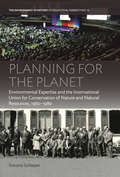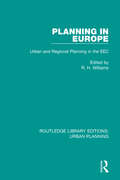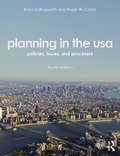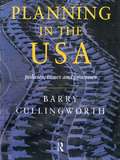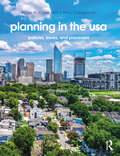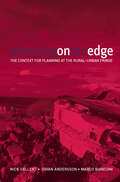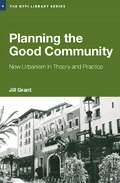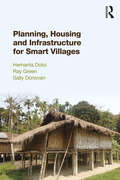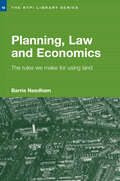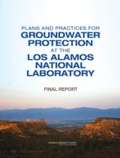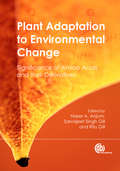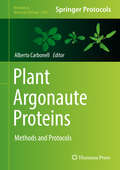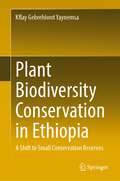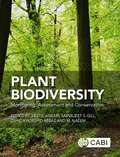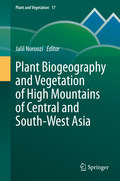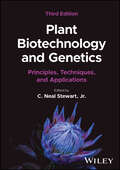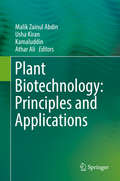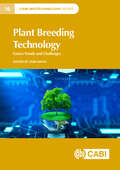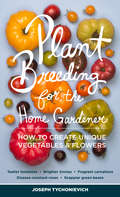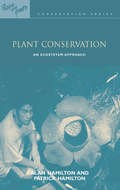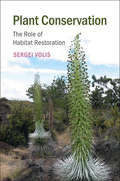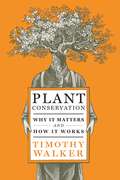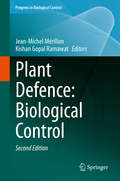- Table View
- List View
Planning for the Planet: Environmental Expertise and the International Union for Conservation of Nature and Natural Resources, 1960–1980 (Environment in History: International Perspectives)
by Simone SchleperDuring the 1960s and 1970s, rapidly growing environmental awareness and concern created unprecedented demand for ecological expertise and novel challenges for ecological advocacy groups such as the International Union for Conservation of Nature and Natural Resources (IUCN). This book reveals how, despite their vast scientific knowledge and their attempts to incorporate socially relevant themes, IUCN experts inevitably struggled to make global schemes for nature conservation a central concern for UNESCO, UNEP and other intergovernmental organizations.
Planning in Europe: Urban and Regional Planning in the EEC (Routledge Library Editions: Urban Planning #22)
by R. H. WilliamsOriginally published in 1984 Planning Urban Europe is a volume of essays reviewing the systems of town and country planning that operate within the member-states of the European Economic Community. The book looks at how the community’s institutions and policies relate to the activity of planning and contributions are written by experts native to the country of study. Each contribution focuses on the scope and style of planning in that country, as opposed to detailed accounts of planning legislation. The book will be of value to practitioners, students and officials wanting to gain an insight into planning elsewhere in Europe.
Planning in the USA
by Roger Caves J. Barry CullingworthThis extensively revised and updated fourth edition of Planning in the USA continues to provide a comprehensive introduction to the policies, theory and practice of planning. Outlining land use, urban planning, and environmental protection policies, this fully illustrated book explains the nature of the planning process and the way in which policy issues are identified, defined, and approached. This full colour edition incorporates new planning legislation and regulations at the state and federal layers of government, updated discussion on current economic issues, and examples of local ordinances in a variety of planning areas. Key updates include: a new chapter on planning and sustainability; a new discussion on the role of foundations and giving to communities; a discussion regarding the aftermath of Katrina in New Orleans; a discussion on deindustrialization and shrinking cities; a discussion on digital billboards; a discussion on recent comprehensive planning efforts; a discussion on land banking; a discussion unfunded mandates; a discussion on community character; a companion website with multiple choice and fill the blank questions, and 'test yourself' glossary terms. This book gives a detailed account of urbanization in the United States and reveals the problematic nature and limitations of the planning process, the fallibility of experts, and the difficulties facing policy-makers in their search for solutions. Planning in the USA is an essential book for students, planners and all who are concerned with the nature of contemporary urban and environmental problems.
Planning in the USA: Policies, Issues and Processes
by Barry CullingworthPlanning in the USA is a comprehensive introduction to the policies, theory and practice of planning. outlining land use, urban planning and environmental protection policies, this fully illustrated book explains the nature of the planning process and the way in which policy issues are identified, defined and approached.Planning in the USA offers a detailed account of urbanization in the USA. Focussing on policies relating to land use, urban planning and environmental protection, Barry Cullingworth reveals the problematic nature and limitations of the planning process, the fallibility of experts, and difficulties facing policy-makers in their search for solutions.Coverage includes:Land Use Regulation Transport, Housing and Community Development Public Attitudes to Planning Property Rights Environmental Planning and PoliciesGrowth Management Planning and Governance Planning problems are seldom easily solved. Barry Cullingworth's Planning in the USA is an essential book for students and planners and all who are concerned with the nature of contemporary urban and environmental problems.
Planning in the USA: Policies, Issues, and Processes
by J. Barry Cullingworth Roger W. CavesExtensively revised and updated, Planning in the USA, fifth edition, continues to provide a comprehensive introduction to the policies, theory, and practice of planning. Outlining land use, urban planning, and environmental protection policies, this fully illustrated book explains the nature of the planning process and the way in which policy issues are identified, defined, and approached. The new edition incorporates new planning legislation and regulations at the state and federal layers of government and examples of local ordinances in a variety of planning areas. New material includes discussions of • education and equity in planning; • the City Beautiful Movement; • Daniel Burnham’s plan for Chicago; • segregation; • Knick v. Township of Scott; • reforming single-family zoning and regulatory challenges in zoning and land use; • Daniel Parolek’s ‘Missing Middle Housing’; • climate change, mitigation, adaptation, and resiliency; • the drinking water crisis in Flint, Michigan; • sharing programs for cars, bicycles, and scooters; • hybrid electric and autonomous vehicles; • Vision Zero; • COVID-19 relief for housing; • Innovation Districts, Promise Zones, and Opportunity Zones; • the sharing, gig, and creative economies; • scenic views and vistas, monuments, statues, and remembering the past; and • healthy cities, Health Impact Assessment, and active living. This detailed account of urbanization in the United States reveals the problematic nature and limitations of the planning process, the fallibility of experts, and the difficulties facing policy-makers in their search for solutions. Planning in the USA, fifth edition, is an essential book for students of urban planning, urban politics, environmental geography, and environment politics. It will be a valuable resource for planners and all who are concerned with the nature of contemporary urban and environmental problems.
Planning on the Edge
by Johan Andersson Nick Gallent Marco BianconiMore than a tenth of the land mass of the UK comprises 'urban fringe': the countryside around towns that has been called 'planning's last frontier'. One of the key challenges facing spatial planners is the land-use management of this area, regarded by many as fit only for locating sewage works, essential service functions and other un-neighbourly uses. However, to others it is a dynamic area where a range of urban and rural uses collide. Planning on the Edge fills an important gap in the literature, examining in detail the challenges that planning faces in this no-man’s land. It presents both problems and solutions, and builds a vision for the urban fringe that is concerned with maximising its potential and with bridging the physical and cultural rift between town and country. Its findings are presented in three sections: the urban fringe and the principles underpinning its management sectoral challenges faced at the urban fringe (including commerce, energy, recreation, farming, and housing) managing the urban fringe more effectively in the future. Students, professionals and researchers alike will benefit from the book's structured approach, while the global and transferable nature of the principles and ideas underpinning the study will appeal to an international audience.
Planning the Good Community: New Urbanism in Theory and Practice (RTPI Library Series)
by Jill GrantAn examination of new urban approaches both in theory and in practice. Taking a critical look at how new urbanism has lived up to its ideals, the author asks whether new urban approaches offer a viable path to creating good communities. With examples drawn principally from North America, Europe and Japan, Planning the Good Community explores new urban approaches in a wide range of settings. It compares the movement for urban renaissance in Europe with the New Urbanism of the United States and Canada, and asks whether the concerns that drive today’s planning theory – issues like power, democracy, spatial patterns and globalisation- receive adequate attention in new urban approaches. The issue of aesthetics is also raised, as the author questions whether communities must be more than just attractive in order to be good. With the benefit of twenty years’ hindsight and a world-wide perspective, this book offers the reader unparalleled insight as well as a rigorous and considered critical analysis.
Planning, Housing and Infrastructure for Smart Villages
by Sally Donovan Ray Green Hemanta DoloiSome 7.3 billion people currently live on the planet. Of these, 3.4 billion live in rural areas. In just a few regions—Latin America, the Middle East and North Africa—less than 50 per cent of poverty is now located in rural areas. But for the rest of the world's regions between 55 per cent and 80 per cent of the poor continue to live in the countryside. Progress is being made, but much of the knowhow needed is not disseminated outside of a small coterie of professionals who work in the area. With urban development attracting a great deal of attention lately, poorer rural areas deserve the same and new knowledge for empowerment of rural communities is urgently needed. This book provides an overview of current thinking and practices that have emerged over the last thirty years for uplifting rural communities in developing economies. Drawing on a body of knowledge across a spectrum of relevant disciplines, this book provides a range of innovative ideas for rural planning, housing and infrastructure development. Governments in many emerging economies, where rural poverty is often most acute, have attempted to improve livelihoods. Approaches and techniques that have been used for urban development are often not applicable to rural communities. Studies show that money allocated for rural development is often not effectively spent due to distance, lack of infrastructure, lack of education, poverty and other factors. Meanwhile, the gap in development between the city and country continues to grow, sometimes leading to social and political instability, in both developing and developed countries. This book seeks to provide a guidebook for meeting such challenges. Through in-depth enquiry of global practices and thinking about rural development, and selected case studies, the authors argue that careful consideration must be given to incorporating issues of resilience, resourcefulness and the involvement of communities at grassroots levels in realising the transformation of rural settlements into Smart Villages.
Planning, Law and Economics: The Rules We Make for Using Land (RTPI Library Series)
by Barrie Needham Edwin Buitelaar Thomas HartmannPlanning, Law and Economics sets out a new framework for applying a legal approach to spatial planning, showing how to improve the practice and help achieve its aims. The book covers planning laws, citizens' rights and property rights, asking ‘What rules do we want to make and, where necessary, enforce? And how do we want to apply them in planning practice?’ This book sets out, in general and illustrated with concrete examples, how the three types of law mentioned above are unavoidably involved in all types of spatial planning. The book also makes clear that these laws can be combined in different ways, each way a particular approach to the practice of spatial planning (regulative planning, structuring markets, pro-active planning, collaborative planning, etc.). Throughout, the book shows what legal approaches can be taken to spatial planning, and uses a four-part framework to evaluate the effects of choosing such an approach. The spatial planning should be effective, legitimate, morally just and economically sound. In particular the book details why the economic effects for society are important and how spatial planning affects how the economic resources of land and buildings are used. The book will be invaluable to students and planners to understand the relationship between their actions and the basic principles of the rule of law in a democratic, liberal society.
Planning, Law and Economics: The Rules We Make for Using Land (RTPI Library Series)
by Barrie NeedhamWhat rights does the state have over privately owned land? Why should some landowners be favoured over others? How can the practice of land-use planning be improved? This book addresses these essential questions and shows that the interests people have in property rights over land and buildings are not just emotional but often financial too. It follows that the law, which affects who has property rights, what those rights are and how they may be used, can have great financial consequences for people and great economic consequences for society in general. For those reasons, looking at land-use planning as it affects and is affected by property rights illuminates some core aspects of land-use planning, including the law, economics, ethics and ideology. In this book, Needham examines those aspects from the clear perspective of property rights.
Plans And Practices For Groundwater Protection At The Los Alamos National Laboratory: Final Report
by National Research Council of the National AcademiesThe National Academies Press (NAP)--publisher for the National Academies--publishes more than 200 books a year offering the most authoritative views, definitive information, and groundbreaking recommendations on a wide range of topics in science, engineering, and health. Our books are unique in that they are authored by the nation's leading experts in every scientific field.
Plant Adaptation to Environmental Change
by Sarvajeet Singh Gill Firdaus Bareen Masayuki Fujita A Aziz Antonio Márquez Antonio Tiburcio Oscar Ruiz Vera Alexieva Bhaskar Gupta B. Vidya Vardhini Renu Bhardwaj Ritu Gill Penna Suprasanna Yoshikatsu Murooka Naser A Anjum Jose Luis MartinezPlants constantly cope with unfavourable ecosystem conditions, which often prevent them reaching their full genetic potential in terms of growth, development and productivity. This book covers plants' responses to these environmental changes, namely, the modulation of amino acids, peptides and amines to combat both biotic and abiotic stress factors. Bringing together the most recent developments, this book is an important resource for researchers and students of crop stress and plant physiology.
Plant Adaptation to Environmental Change: Significance of Amino Acids and their Derivatives
by Firdaus Bareen Masayuki Fujita A Aziz Antonio Márquez Antonio Tiburcio Oscar Ruiz Vera Alexieva Bhaskar Gupta B. Vidya Vardhini Renu Bhardwaj Penna Suprasanna Yoshikatsu Murooka Jose Luis MartinezPlants constantly cope with unfavourable ecosystem conditions, which often prevent them reaching their full genetic potential in terms of growth, development and productivity. This book covers plants' responses to these environmental changes, namely, the modulation of amino acids, peptides and amines to combat both biotic and abiotic stress factors. Bringing together the most recent developments, this book is an important resource for researchers and students of crop stress and plant physiology.
Plant Argonaute Proteins
by Alberto CarbonellThis volume provides the reader with step-by-step methods to study plant ARGONAUTE (AGO) functions. Chapters in Plant Argonaute Poteins: Methods and Protocols summarize the main biochemical, molecular and cytological methods to study AGO-small RNA complexes and their interactions with target RNAs, AGO subcellular localization, AGO association with polysomes, AGO role in meiosis and DNA repair, methods for the identification, cloning and characterization of AGO genes in different plant species, and non-radioactive protocols for small RNA detection. Finally, a series of chapters describing computational methods to study plant AGO function and evolution are provided. Written in the highly successful Methods in Molecular Biology series format, chapters include introductions to their respective topics, lists of the necessary materials and reagents, step-by-step, readily reproducible laboratory protocols, and tips on troubleshooting and avoiding known pitfalls. Authoritative and practical, Plant Argonaute Proteins: Methods and Protocols aims to deliver the most complete and updated list of protocols to study plant AGO function.
Plant Biodiversity Conservation in Ethiopia: A Shift to Small Conservation Reserves
by Kflay Gebrehiwot YaynemsaThis book covers biodiversity conservation under special consideration of the challenges in the global south with particular attention being paid to consider the existing conservation challenges in relation to the study area in Ethiopia. Key issues are addressed, such as the current and future threats to plant biodiversity in Ethiopia, as well as the single large or several small conservation approaches and which approach is feasible for Ethiopia. Furthermore, an innovative approach was developed that enhances ecological connectivity and promotes ecological restoration through community involvement. The book also covers why a systematic conservation planning approach is important and should be used in new protected area establishments, and also looks at the trends of plant ecology research over the past five decades, revealing research gaps and suggesting future research topics. Despite its focus on Ethiopian plant diversity, abundant examples were used from different continents making this book attractive to global readers. It will be of interest for policy- and decision-makers in the conservation sector, researchers interested in biodiversity, climate change, conservation and sustainable use of natural resources, and would be a valuable resource for university students.
Plant Biodiversity: Monitoring, Assessment and Conservation
by Nishanta Rajakaruna Tarique Hassan Askary Mohammad Mobin Munir Ozturk Sanjeev Kumar Zahid Khorshid Abbas Subrata Trivedi Hasibur Rehman Anand Mohan Volkan Altay Shabir Ahmad Mir Mohammad Maqbool Mir Shalini Saggu Maria Amélia Martins-Loução Gisela Gaio-Oliveira Umar Iqbal Shafat Ahmad Banday Sheikh Mehraj Munib Ur Rehman Ghulam Hasan Rather Sunit Mitra Sobhan Kumar Mukherjee Kathryn E Barry Stefan A Schnitzer Salih Gucel Syed Baker K S Kavitha P. Azmath D Rakshith B P Harini S Satish Asma-Hammami Semmar Nabil Semmar Otília Correia Lia Ascensão Sulaiman Mohammad Al-Ghanim Fahad Mohammed Alzeibar Mudasir Irfan Dar Mohd Irfan Naikoo Fareed Ahmad Khan Farha Rehman Fouzia Nousheen H C Rao Martin T Dokulil Gopal Shukla Nazir A Pala Saikat Gantait Sumit Chakravarty Jyoti K Sharma Saiful Islam S M Sundarapandian K Subashree Pundarikakshudu Tetali Sujata Tetali Sankar K Ghosh Anjula Pandey K Pradheep K S Negi José Antonio González Ana Maria Carvalho Francisco Amich Uma Rani Sinniah Narayan Chandra Sahu Abir Sarraj Meg Trau Robin Owings Petros Ganatsas Disha Jaggi Mayank Varun Saurabh Pagare Niraj Tripathi Meenal Rathore Raghwendra Singh Bhumesh KumarResults of regular monitoring of the species diversity and structure of plant communities is used by conservation biologists to help understand impacts of perturbations caused by humans and other environmental factors on ecosystems worldwide. Changes in plant communities can, for example, be a reflection of increased levels of pollution, a response to long-term climate change, or the result of shifts in land-use practices by the human population. This book presents a series of essays on the application of plant biodiversity monitoring and assessment to help prevent species extinction, ecosystem collapse, and solve problems in biodiversity conservation. It has been written by a large international team of researchers and uses case studies and examples from all over the world, and from a broad range of terrestrial and aquatic ecosystems. The book is aimed at any graduate students and researchers with a strong interest in plant biodiversity monitoring and assessment, plant community ecology, biodiversity conservation, and the environmental impacts of human activities on ecosystems.
Plant Biogeography and Vegetation of High Mountains of Central and South-West Asia (Plant and Vegetation #17)
by Jalil NorooziThis book presents an overview study about plant biogeography and vegetation of the high mountains of Central and South-West Asia, by a group of specialists familiar with its area and plant growth and ecology. This book discusses its ecological and evolutionary drivers and also its conservation priorities.Central and South-West Asia is one of the most diverse areas in the northern hemisphere and several biodiversity hotspots are concentrated in this region. Most of the biodiversity hotspots are associated with high mountain ranges of the region. Moreover, these mountains have been immigration corridors for the Central Asian flora to reach Euro-Siberian and Mediterranean regions. Despite its importance, there is no overview publication to present the plant biogeography and vegetation of these mountains and most of the publications are local or rather imprecise
Plant Biotechnology and Genetics: Principles, Techniques, and Applications
by C. Neal StewartDiscover the latest edition of this authoritative textbook on plant biotechnology and genetics Plant biotechnology is a field of research and development in which scientific techniques are brought to bear on the creation and modification of new, beneficial plants and strains. Biotechnological techniques can be used to add nutritive value, increase resistance to diseases and pests, increase yields, and more. The production of biotech crops has increased over one hundred times since their introduction into commercial agriculture in 1996, making them the most rapidly-adopted crop category in the history of modern agriculture. Plant Biotechnology and Genetics is the essential introduction to this thriving research subject. Beginning with an overview of basic plant biology and genetics, it then moves to the fundamental elements of biotechnology. Now fully updated to reflect the latest research advances and technological breakthroughs, it continues to be a must-own for readers interested in the future of food production and more. Readers of the third edition of Plant Biotechnology and Genetics will also find: New chapters covering topics like genome editing, chloroplast genome engineering, and synthetic biologyUpdates throughout to incorporate increased coverage of haploid production, genomic selection, and moreSummary and discussion questions in each chapter, along with a companion website incorporating images and lecture materials Plant Biotechnology and Genetics is ideal for advanced undergraduate and masters students in plant biotechnology courses, as well as professionals seeking a helpful reference guide.
Plant Biotechnology: Principles and Applications
by Malik Zainul Abdin Usha Kiran Kamaluddin Athar AliThe book traces the roots of plant biotechnology from the basic sciences to current applications in the biological and agricultural sciences, industry, and medicine. Providing intriguing opportunities to manipulate plant genetic and metabolic systems, plant biotechnology has now become an exciting area of research. The book vividly describes the processes and methods used to genetically engineer plants for agricultural, environmental and industrial purposes, while also discussing related bioethical and biosafety issues. It also highlights important factors that are often overlooked by methodologies used to develop plants' tolerance against biotic and abiotic stresses and in the development of special foods, bio-chemicals, and pharmaceuticals. The topics discussed will be of considerable interest to both graduate and postgraduate students. Further, the book offers an ideal reference guide for teachers and researcher alike, bridging the gap between fundamental and advanced approaches.
Plant Breeding Technology: Future Trends and Challenges (CABI Biotechnology Series)
by Zeba KhanThis book highlights the latest and most exciting technological tools for plant breeding that are becoming the staple of all crop improvement programs. Using case studies and an evidence-based approach to examine the current status of each technique, the book discusses the challenges so far uncovered and future trends. Crop improvement relies on modulating the genes and genomic regions underlying key traits, either directly or indirectly. Direct approaches include overexpression, RNA interference, and genome editing, while conventional breeding constitutes the indirect approach. The integration of cutting-edge tools and technologies has the potential to expedite improvements in crop species. Innovations such as next-generation sequencing, high-throughput genotyping, precision editing, and the utilization of space technology to accelerate growth have opened new avenues in crop improvement programs, aimed at delivering new crop varieties capable of resilience to a variety of challenges. The book presents a systematic guide to various genomics approaches deployed for trait discovery and improvement in crop species. The chapters comprehensively cover each application, its advantages, and disadvantages, and its potential for improvement, supported by illustrative examples. The book: · Emphasizes the latest scientific and technological tools which are becoming the norm in all major crop improvement programs · Explores innovative approaches and cutting-edge technologies utilized in the development and improvement of climate-resilient crops. · Each chapter is supplemented with ample illustrations to clarify and summarize the key points and provides an easy-to-understand overview of the most important concepts, applications and advances in crop improvement technologies.
Plant Breeding for the Home Gardener: How to Create Unique Vegetables and Flowers
by Joseph TychonievichBrighter zinnias, fragrant carnations, snappier green beansPlant Breeding for the Home Gardener makes it easier than ever to breed and grow your own varieties of vegetables and flowers. This comprehensive and accessible guide explains how to decide what to breed, provides simple explanations on how to cross plants, and features a basic primer on genetics and advanced techniques. Case studies provide breeding examples for favorite plants like daffodils, hollyhocks, roses, sweet corn, and tomatoes.
Plant Conservation: An Ecosystem Approach (People And Plants International Conservation Ser.)
by Alan HamiltonIn this, the latest in the People and Plants series, plant conservation is described in the context of livelihoods and development, and ways of balancing the conservation of plant diversity with the use of plants and the environment for human benefit are discussed. A central contention in this book is that local people must be involved if conservation is to be successful. Also examined are ways of prioritizing plants and places for conservation initiatives, approaches to in situ and ex situ conservation, and how to approach problems of unsustainable harvesting of wild plants. Roles for botanists, foresters, sociologists, development workers and others are discussed. This book acts as a unifying text for the series, integrating case studies and methodologies considered in previous volumes and pointing out in a comprehensive, accessible volume the valuable lessons to be learned.
Plant Conservation: The Role of Habitat Restoration
by Sergei VolisThe rate of species and natural habitat loss across our planet is steadily accelerating. This book argues that existing practises of plant conservation are inadequate and firmly supports the placement of ecological restoration at the cornerstone of biodiversity conservation. The author unifies different aspects of conservation into one coherent concept, including natural area protection, ex situ conservation and in situ interventions through either population management or ecological restoration. Assisted colonization, experimentation, and utilization of threatened plant species are raised as crucial elements in restoration, with partly novel ecosystems being among its major target areas. Covering a wide spectrum of plant conservation examples, and offering practical methodologies alongside the theoretical context, this is a vital resource for students, research scientists and practitioners in conservation biology and restoration ecology.
Plant Conservation: Why It Matters and How It Works
by Timothy WalkerPlants’ ability to turn sunlight into energy makes them the basis for all life; without them there is no life. And they are more than just a food source—they provide us with fuel, fibers, and pharmaceuticals. Global warming and the destruction of natural habitats are a serious threat to many plants, and there are worldwide efforts to mitigate the disaster. Plant Conservation tackles this essential topic head on. Timothy Walker, as the director of the Oxford Botanical Garden, a leader in the field of plant conservation, plays a key role in this effort. He highlights what is happening now, from cataloging the world’s flora to conservation efforts like protecting plants from overcollecting. He also shows home gardeners how they can become involved, whether by growing their own food to decrease reliance on large agriculture or by making smart plant choices by growing natives and avoiding invasives. Plant Conservation treats a critical topic in an accessible and optimistic way. It is required reading for students, professionals, and anyone with a keen interest in the importance of plants.
Plant Defence: Biological Control (Progress in Biological Control #22)
by Kishan Gopal Ramawat Jean-Michel MérillonInsects, pests and weeds are responsible for substantial loss of crops and reduced food supplies, poorer quality of agricultural products, economic hardship for growers and processor. Generally, chemical control methods are neither always economical nor are they effective and may have associated unwanted health, safety and environmental risks. Biological control involves use of beneficial biological agents to control pests and offers an environmental friendly approach to the effective management of plant diseases and weeds. The chapters are written by well recognized group leaders in the field. This book provides a comprehensive account of interaction of host and pests, and development of biological control agents for practical applications in crops management utilizing inherent defence mechanism, induced stimulation and biological control agents. The contents are divided into the following sections: General biology of plant defence, Use of natural compounds for biological control, Use of biological agents, Mechanism of action and Commercial aspects. The book will be useful for academicians, researcher and industries involved in study and manufacturing these products.
